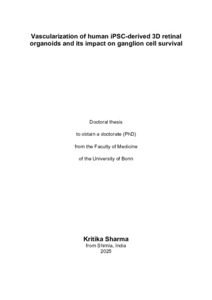Sharma, Kritika: Vascularization of human iPSC-derived 3D retinal organoids and its impact on ganglion cell survival. - Bonn, 2025. - Dissertation, Rheinische Friedrich-Wilhelms-Universität Bonn.
Online-Ausgabe in bonndoc: https://nbn-resolving.org/urn:nbn:de:hbz:5-80649
Online-Ausgabe in bonndoc: https://nbn-resolving.org/urn:nbn:de:hbz:5-80649
@phdthesis{handle:20.500.11811/12746,
urn: https://nbn-resolving.org/urn:nbn:de:hbz:5-80649,
author = {{Kritika Sharma}},
title = {Vascularization of human iPSC-derived 3D retinal organoids and its impact on ganglion cell survival},
school = {Rheinische Friedrich-Wilhelms-Universität Bonn},
year = 2025,
month = jan,
note = {ROs have emerged as a transformative platform for studying retinal cell development and modeling retinal diseases. These 3D structures, derived from SCs, replicate the architecture and function of the retina, offering crucial insights into retinal biology and pathology. However, a major limitation is the lack of functional vasculature, which restricts their ability to sustain nutrient and oxygen supply over time. This shortfall results in cell death and diminished functionality, particularly affecting RGCs, which are essential for transmitting visual signals from the retina to the brain. The failure of RGCs in ROs to extend axons as they do in vivo further compromise their survival and limits the organoids’ utility for studying retinal circuitry and function. The absence of a vascular network exacerbates these challenges by preventing the organoids from reaching the physiological conditions necessary for optimal cell growth and activity.
In this study, we introduce a novel approach to overcome these limitations by establishing a vascular-like system within ROs. This system incorporates functional lumens and transient pericyte-like cells, crucial for maintaining vascular integrity. The introduction of this vascular-like structure significantly enhances organoid size, reduces apoptosis in aging organoids, and preserves RGC populations. This breakthrough improves organoid viability and their potential for studying retinal diseases and therapeutic interventions. To further optimize functionality, we integrated optogene, ChRimson to label RGC axons and allow their direct recording activity on MEAs. Our results showed significantly increased RGC firing rates, with burst durations reaching up to 300 Hz, indicating robust neuronal activity. Additionally, vROs displayed synchronous activity and enhanced bursts in response to light stimulation, suggesting functional maturation of RGCs. This maturation is crucial for developing functional photoreceptor circuitry, which is essential for advancing our understanding of retinal function and devising potential therapies for retinal disorders.
In conclusion, the incorporation of a vascular-like system in ROs represents a substantial advancement, enhancing both RGC survival and functionality. This innovation addresses key limitations of traditional organoid models and opens new possibilities for using ROs as a powerful tool in biomedical research, particularly in studying retinal diseases and developing therapeutic strategies.},
url = {https://hdl.handle.net/20.500.11811/12746}
}
urn: https://nbn-resolving.org/urn:nbn:de:hbz:5-80649,
author = {{Kritika Sharma}},
title = {Vascularization of human iPSC-derived 3D retinal organoids and its impact on ganglion cell survival},
school = {Rheinische Friedrich-Wilhelms-Universität Bonn},
year = 2025,
month = jan,
note = {ROs have emerged as a transformative platform for studying retinal cell development and modeling retinal diseases. These 3D structures, derived from SCs, replicate the architecture and function of the retina, offering crucial insights into retinal biology and pathology. However, a major limitation is the lack of functional vasculature, which restricts their ability to sustain nutrient and oxygen supply over time. This shortfall results in cell death and diminished functionality, particularly affecting RGCs, which are essential for transmitting visual signals from the retina to the brain. The failure of RGCs in ROs to extend axons as they do in vivo further compromise their survival and limits the organoids’ utility for studying retinal circuitry and function. The absence of a vascular network exacerbates these challenges by preventing the organoids from reaching the physiological conditions necessary for optimal cell growth and activity.
In this study, we introduce a novel approach to overcome these limitations by establishing a vascular-like system within ROs. This system incorporates functional lumens and transient pericyte-like cells, crucial for maintaining vascular integrity. The introduction of this vascular-like structure significantly enhances organoid size, reduces apoptosis in aging organoids, and preserves RGC populations. This breakthrough improves organoid viability and their potential for studying retinal diseases and therapeutic interventions. To further optimize functionality, we integrated optogene, ChRimson to label RGC axons and allow their direct recording activity on MEAs. Our results showed significantly increased RGC firing rates, with burst durations reaching up to 300 Hz, indicating robust neuronal activity. Additionally, vROs displayed synchronous activity and enhanced bursts in response to light stimulation, suggesting functional maturation of RGCs. This maturation is crucial for developing functional photoreceptor circuitry, which is essential for advancing our understanding of retinal function and devising potential therapies for retinal disorders.
In conclusion, the incorporation of a vascular-like system in ROs represents a substantial advancement, enhancing both RGC survival and functionality. This innovation addresses key limitations of traditional organoid models and opens new possibilities for using ROs as a powerful tool in biomedical research, particularly in studying retinal diseases and developing therapeutic strategies.},
url = {https://hdl.handle.net/20.500.11811/12746}
}





